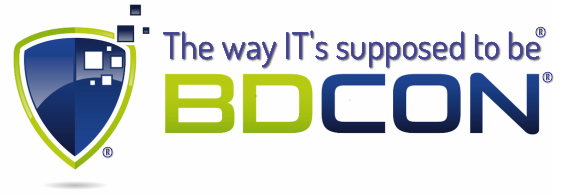
If many of the technology industry insiders are to be believed, email is all but dead. 99% of all email messages circulated through the internet are spam. Here are BDCon, we spend a considerable amount of time ensuring our customers are seeing only relevant messages in their inbox and protecting them from phishing and malware attacks. The amount of email messages being sent to each other is rapidly decreasing in favor of things like text messaging, Skype and Face Time calls, and online video conferencing services such as GoTo Meeting. However, there is one aspect to enterprise email that continues to be a struggle for end users. The problem of sharing files, specifically large files, has been a thorn in the side of business for years. Here are some thoughts on what you can do to help deal with what is inevitably going to be more and more prevalent in the coming years.
The problem of how to securely share files has been a plague among business for years. So much so that there are dozens of ways that business have solved the problem for themselves. The problem with having so many solutions is that they either: A. Require others to sign up for services to be able to participate in file sharing or B. Depend upon other methods of delivery that seem to kill the idea of productively sharing files all together.
An example of the latter is the system of dropping files onto a form of portable media such as a USB drive or writable disc and then manually delivering the media to the recipient. This method has several obvious weaknesses. Speed is the first that comes to mind. If the recipient happens to be located a considerable distance away, than shipping the media involves additional costs and a considerable amount of time. Need to get those files to someone today? The "Sneaker Net" method is not going to get it done in most cases. There are also considerable security concerns with this method. If the files being transported are sensitive in nature, how do you insure that they are delivered and viewed only by the intended recipient?
As far as cloud based file sharing services are concerned, there are dozens, maybe even hundreds, of choices. It can be overwhelming trying to determine which is the best option for your business but there are some things you should consider first when evaluating a provider. First, it's important to determine if the service you're looking at is designed for business. Many services are built around sharing photos of the kids and not 30 megabytes of medical records. It really all comes down to two factors: Security and Collaboration.
A top quality enterprise cloud storage service should have top notch security. DropBox, one of the most popular services, has been plagued by security issues. Most of these stem from the fact that the service was built on a platform designed for consumers. Another issue with services like DropBox and Drive is that accounts are individualized for the most part. It is very difficult to administer the use of these services since many users are using individually created accounts. There is virtually no difference between allowing this, and allowing employees to put their files onto their personal computers. IT security has no way of tracking what files are where, and who has accessed them. When an employee leaves the company, they still have access to any company files that are stored there. These problems face nearly all of the cloud file sharing services out there.
There is one service that we highly recommend for use in an enterprise environment. The system is called Soonr and the reason you've probably never heard of it is because they originally only marketed their system as a private, cloud based service to Fortune 500 companies. Soonr allows companies to manage their cloud file sharing in any number of ways that make it much safer. The platform utilized very robust permissions to restrict file access. Users can make files read only, downloadable, editable all within the Soonr environment. And since it's managed at the enterprise level, when an employee leaves, their access to anything in the system is revoked with a few mouse clicks. Sharing files with clients is as easy as email them a link. Soonr users can even email a special link to clients to enable uploading into their Soonr workspace.
If you're working with larger files that need to be shared with others outside or even inside your organization, you owe it to yourself and your clients to take a look at Soonr. Feel free to contact us for more information and we'll help you.
The problem of how to securely share files has been a plague among business for years. So much so that there are dozens of ways that business have solved the problem for themselves. The problem with having so many solutions is that they either: A. Require others to sign up for services to be able to participate in file sharing or B. Depend upon other methods of delivery that seem to kill the idea of productively sharing files all together.
An example of the latter is the system of dropping files onto a form of portable media such as a USB drive or writable disc and then manually delivering the media to the recipient. This method has several obvious weaknesses. Speed is the first that comes to mind. If the recipient happens to be located a considerable distance away, than shipping the media involves additional costs and a considerable amount of time. Need to get those files to someone today? The "Sneaker Net" method is not going to get it done in most cases. There are also considerable security concerns with this method. If the files being transported are sensitive in nature, how do you insure that they are delivered and viewed only by the intended recipient?
As far as cloud based file sharing services are concerned, there are dozens, maybe even hundreds, of choices. It can be overwhelming trying to determine which is the best option for your business but there are some things you should consider first when evaluating a provider. First, it's important to determine if the service you're looking at is designed for business. Many services are built around sharing photos of the kids and not 30 megabytes of medical records. It really all comes down to two factors: Security and Collaboration.
A top quality enterprise cloud storage service should have top notch security. DropBox, one of the most popular services, has been plagued by security issues. Most of these stem from the fact that the service was built on a platform designed for consumers. Another issue with services like DropBox and Drive is that accounts are individualized for the most part. It is very difficult to administer the use of these services since many users are using individually created accounts. There is virtually no difference between allowing this, and allowing employees to put their files onto their personal computers. IT security has no way of tracking what files are where, and who has accessed them. When an employee leaves the company, they still have access to any company files that are stored there. These problems face nearly all of the cloud file sharing services out there.
There is one service that we highly recommend for use in an enterprise environment. The system is called Soonr and the reason you've probably never heard of it is because they originally only marketed their system as a private, cloud based service to Fortune 500 companies. Soonr allows companies to manage their cloud file sharing in any number of ways that make it much safer. The platform utilized very robust permissions to restrict file access. Users can make files read only, downloadable, editable all within the Soonr environment. And since it's managed at the enterprise level, when an employee leaves, their access to anything in the system is revoked with a few mouse clicks. Sharing files with clients is as easy as email them a link. Soonr users can even email a special link to clients to enable uploading into their Soonr workspace.
If you're working with larger files that need to be shared with others outside or even inside your organization, you owe it to yourself and your clients to take a look at Soonr. Feel free to contact us for more information and we'll help you.

 RSS Feed
RSS Feed